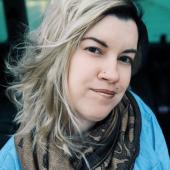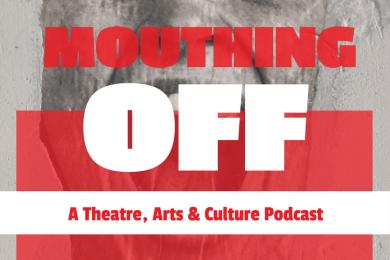The Legacy of VSA Minnesota
On September 30th, Minnesota will say farewell to its inclusionary champion of the Arts—VSA Minnesota. Since 1986, VSA Minnesota has been the state organization on Arts and Disability, with their mission “to create a community where people with disabilities can learn through, participate in and access the arts.” When I was approached to conduct an interview with Executive Director Craig Dunn, and Accessibility & Grants Coordinator Jon Skaalen on the closing of VSA Minnesota, I seized the opportunity. Having been acquainted with Craig the last several years, and myself being an artist with a disability, I wanted to make sure the legacy of VSA Minnesota will not be soon forgotten.
AK: How did you begin your time at VSA?
Craig Dunn: I joined the Board of Directors in 1988. I had seen an exhibit of visual artwork by students with various disabilities in the cortile at Landmark Center in downtown St. Paul during the summer of 1988 and it had information about Very Special Arts Minnesota. I gave them a call and shared my interest in the work that they were doing. By that fall, I was asked onto the board and quickly became chair of the program committee. By the following fall, I was Board President. The next three years were somewhat turbulent with the organization almost closing its doors when it was discovered that the Executive Director had been stealing from the organization. As a result of the turbulence, there was no staff at the beginning of 1991. I served as a volunteer Executive Director for five months until we identified a person to become a half-time director. That individual chose to resign in mid-1992 and that was when I resigned from the board and was hired as the half-time E.D. I worked half-time for two years before going full-time in 1994.
Jon Skaalen: Twenty years ago (August 1999) is hard to remember, but I believe I learned about VSA (at that time Very Special Arts) through a variety of arts and disability connections. I learned about lots of disability issues during seven years at PACER Center, a resource center for children and young adults with disabilities. I became friends with several blind theater-lovers, including Eric Peterson and Rachel Parker, who used a new service called audio description to enjoy plays at the Guthrie Theater. Since I volunteered and worked for the Minnesota Association of Community Theatres (MACT), we started trying to make our play festivals more accessible. Around that time I met Craig Dunn at several events featuring artists with disabilities like Kevin Kling and Leslye Orr. When one job ended, it was good fortune that a part-time position became available with VSA. My past work with newsletters, communication, public events, artists and people with disabilities, apparently qualified me, and the part-time job eventually turned full-time.
AK: What has been the most rewarding aspect of your work with VSA?
CD: I have met so many great people doing so many great things to make the arts accessible to people with disabilities around the state of Minnesota and around the world. Very Special Arts then VSA arts and then just VSA was an international organization. Through the international festivals held in Washington, D.C., Los Angeles and Brussels, Belgium, I came to know artists with disabilities, arts administrators, teaching artists and disability advocates that were stretching the boundaries of what most people thought of as work in the arts. It expanded what I thought of as possible when thinking about disability and when thinking about art. Whether it is Gaelynn Lea of Duluth as a performer or the late Danny Gayder as a visual artist or Jaehn Clare as a theatre performer, writer and teaching artist – all these artists opened my eyes to excellence in the arts by a person with a disability
JS: I am fascinated by artists who create something out of nothing, or who put their own spin on interpreting and responding to life in one or more art mediums. I love being exposed to new perspectives and challenging issues framed by artists from different cultures, including disability culture. Exploring differences and discovering common ground is a way to grow, I think. And while I can identify with white male Norwegians, I probably learn more by seeing a black woman in a wheelchair or a nonverbal guy or a transgender youth or a senior losing her vision and hearing. Maybe I just like storytelling, as my grandma used to do, and I’ve been totally enriched by each human’s story and journey – including those expressed by the artists with disabilities I’ve come to know through VSA.
AK What are you most concerned about with VSA closing in a few months? How will the Minnesota arts scene change for the community?
CD: There will no longer be a “one-stop shop” in the state when it comes to finding information and resources in the intersecting circles of arts, education and disability. Lots of organizations are doing great things in these areas but there will no longer be one organization or one set of employees who will know what/where/who 98% of those things are. It will mean that arts administrators and artists with disabilities will have to work a little harder and be a little more persistent in getting information they are seeking. It will probably mean that they make connections with new people or organizations that will assist them in moving forward but they will have to work a little harder.
JS: I feel it’s important to know where to go or whom to call to find information or get help – with minimal run-around and buck-passing. We’ve been able to facilitate that “one-stop shopping” kind of approach, and I hope something similar can evolve. But in the meantime each group and person needs to be responsible to chip in and ACTIVELY support access to the arts for all. Communication will be important in helping artists and patrons with/without disabilities and arts organizations know where to go to:
* hire an artist with a disability;
* request whatever accessibility accommodation they need to participate in public events;
* reach a bunch of people who can use these services so we can maximize our investment in being accessible;
* find funding sources, whether for artists, audience members or organizations; and
* learn what the law says, or ways to be a positive influence on making access to the arts even more of a reality than it is today.
AK: What can the community do to ensure the great work of VSA continues on?
CD: As I am telling people in a final series of workshops I am doing around the state, the mission that was VSA Minnesota’s – creating a community where people with disabilities learn through, participate in and access the arts – will now have to become a part of every one of Minnesota’s arts organization’s missions. It now becomes a shared responsibility of the state arts community to reach out, engage and accommodate the various abilities and needs of artists, participants, volunteers and prospective employees that have disabilities. I think we have planted some very good seeds over our 33 years of work and we are confident that good fruit will be borne.
JS: Advocate for accessibility everywhere and for inclusion of people with differences on stages and in audiences – beginning on Day One of planning for an event. Advocate for more accessibility training and coordinators who aren’t just the newest person aboard. Advocate for using funding (like Legacy Amendment funding) to make every facility accessible and every event potentially accessible to someone with vision, hearing or other disabilities. Advocate for budgeting for accessibility (including more dedicated funding at the State Arts Board) and getting people on our boards who aren’t going to grouse about how much it costs but will understand and appreciate having everyone at the table.
AK: What are your plans for after VSA?
CD: I have joined the board of the Metro Regional Arts Council and will assist that organization in its efforts to fund arts organizations and projects in the 7-county metro area. I will offer myself out as an arts access consultant to arts organizations in the state and region for at least the coming year. I look to do some traveling around the country and world seeing places that I have heard about in my work and now might be able to visit. Although there are times when I just enjoy sitting and watching the world go by, I know that I get antsy pretty quickly, so I will be keeping my feet moving and my mind engaged in new things that happen to cross my path.
JS: I’m going to read and write and see plays and listen to music and meet (and vote for) people who value our beautiful world of diversity – and the need to preserve truth and beauty for everyone, not only those whose penthouses were paid for by putting other people down. Thus, I’ll probably volunteer (or work) a lot in order to do these things. When you see me, remind me that I’m also going to exercise….
Jon
VSA: 612-332-3888 or 612-305-0132, [email protected]
Cell: 612-819-0949
Stillwater: 651-439-3362, [email protected]




